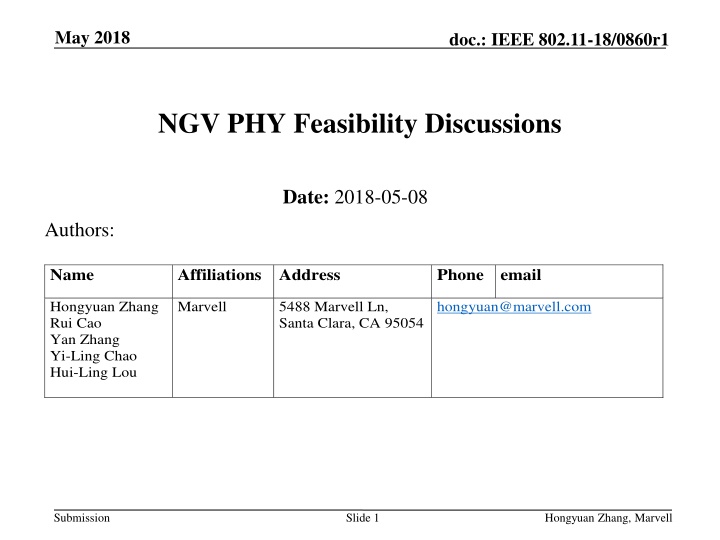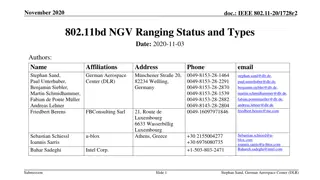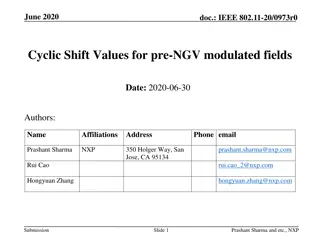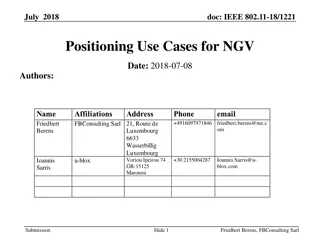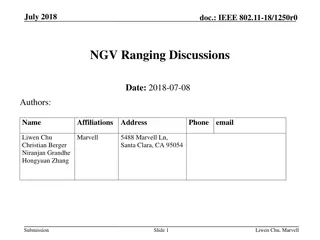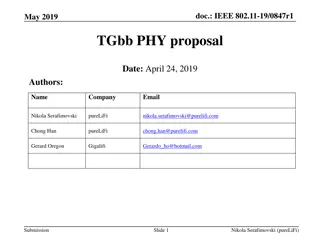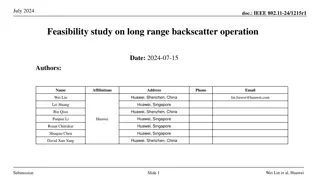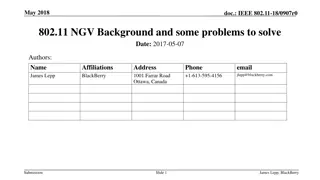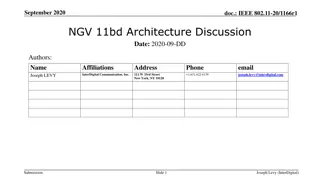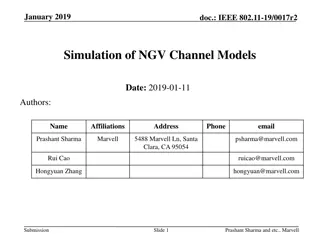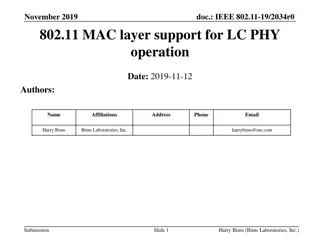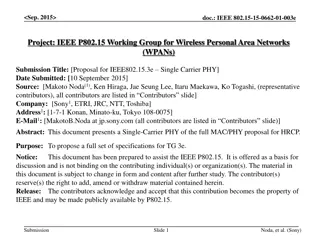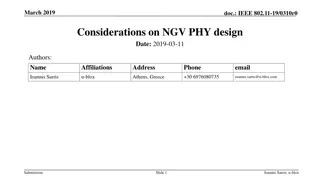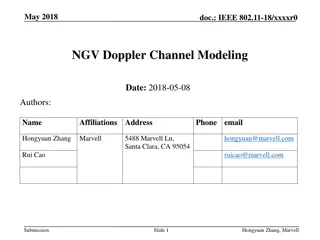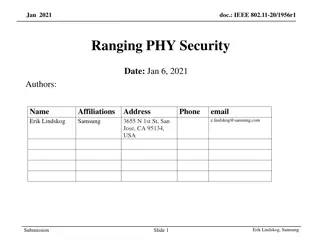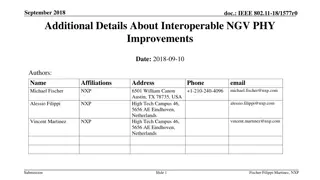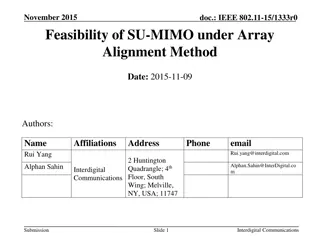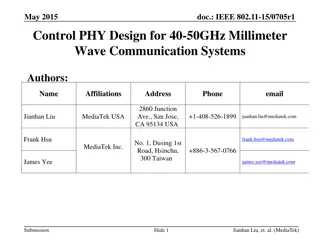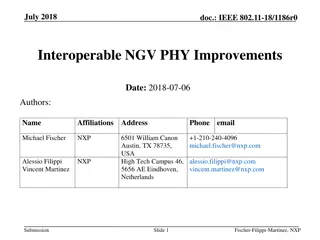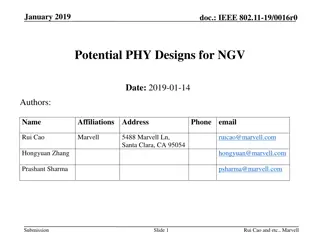Feasibility Discussions on NGV PHY Enhancement in IEEE 802.11-18
NGV SG's efforts to enhance throughput and range beyond 11p for safety applications, exploring potential use cases, discussing PHY technology candidates for performance improvements, and comparing parameters like modulation, coding, and recovery methods.
Download Presentation

Please find below an Image/Link to download the presentation.
The content on the website is provided AS IS for your information and personal use only. It may not be sold, licensed, or shared on other websites without obtaining consent from the author.If you encounter any issues during the download, it is possible that the publisher has removed the file from their server.
You are allowed to download the files provided on this website for personal or commercial use, subject to the condition that they are used lawfully. All files are the property of their respective owners.
The content on the website is provided AS IS for your information and personal use only. It may not be sold, licensed, or shared on other websites without obtaining consent from the author.
E N D
Presentation Transcript
May 2018 doc.: IEEE 802.11-18/0860r1 NGV PHY Feasibility Discussions Date: 2018-05-08 Authors: Name Affiliations Address Phone email Hongyuan Zhang Rui Cao Yan Zhang Yi-Ling Chao Hui-Ling Lou Marvell 5488 Marvell Ln, Santa Clara, CA 95054 hongyuan@marvell.com Submission Slide 1 Hongyuan Zhang, Marvell
May 2018 doc.: IEEE 802.11-18/0860r1 Introduction NGV SG was formed to enhance the throughput and possibly range from 11p [1]. Meanwhile [1] stresses that 11p is sufficient for basic safety applications. NGV PAR scope description may need to specify quantitative performance enhancement . Some preliminary estimation on the PHY feasibility might be necessary to assist setting the PAR scope. PHY Technology Candidates Channelization and Coex with 11p Submission Slide 2 Hongyuan Zhang, Marvell
May 2018 doc.: IEEE 802.11-18/0860r1 Possible More Use Cases for NGV 11p mostly used for basic safety: vehicles broadcast basic safety message (BSM) : vehicle status, speed, position, direction, etc. With the goal of enhancing rate at range , NGV may assist with more usage cases, for example: Enhanced safety features: more vehicle information (sensors), intention awareness, condition awareness, local HD map, etc. Assisting autonomous driving: more intensive data communications between cars High accuracy positioning (Infrastructure based) Submission Slide 3 Hongyuan Zhang, Marvell
May 2018 doc.: IEEE 802.11-18/0860r1 I. PHY Technology Candidates-1 As stated in [1], there are quite some low hanging fruits PHY features developed along with the 802.11 amendments in the recent decade (after 802.11p). By selecting some of these existing technologies we may get enhancements especially for high throughputs and/or longer range: OFDM Numerology Design: Tone Spacing, GI Duration LDPC STBC Multi-Antenna, CSD Midamble Range Extension DCM 20MHz PHY (Ch181, Ch175) Submission Slide 4 Hongyuan Zhang, Marvell
May 2018 doc.: IEEE 802.11-18/0860r1 PHY Technology Candidates-2 PHY Parameter Comparison CV2X (Mode 4) 802.11p NGV Modulation SC-FDM OFDM OFDM Tone Spacing 15 kHz 156.25 kHz Candidates: 156.25 kHz, 78.125 kHz, others? GI 4.69us, 5.2us 1.6us Candidates: 1.6us, 3.2us, others? Doppler Target (speed) 250km/h 200km/h TBD (250km/h?) Coding Turbo, BCC (tail biting) BCC Candidates: LDPC, others? Lowest Rate QPSK 1/3 Coding 3Mbps (BPSK, ) Candidates: MCS0, MCS0+DCM, range extension mode, others? Highest Rate 16QAM 1/2 Coding (V2V) 256QAM 0.9 (eNB assisted) 27Mbps (64QAM, ) Fixing at 6Mbps for BSM broadcasting Candidates: MCS7, MCS9, others? Doppler Recovery Method High density DMRS (demodulation reference signal) symbols None (Up to Rx implementation) Candidates: High density midambles, others? Submission Slide 5 Hongyuan Zhang, Marvell
May 2018 doc.: IEEE 802.11-18/0860r1 PHY Technology Candidates-3 No optional feature, since the MAC might still be based on Outside the Context of a BSS (OCB), same as 11p. Since original 11p, MIMO was commonly applied in regular 802.11 designs in 2.4GHz and 5GHz, it is natural to use multi-antenna also in DSRC, e.g. 2x2 design. With OCB, when multiple antenna is deployed, we may not define >1SS rates, since there could be mixture of 1x1 and 2x2 (or larger) deployments. Suggest only define 1SS, and define CSD: for both NGV rates and 11p rates. Submission Slide 6 Hongyuan Zhang, Marvell
May 2018 doc.: IEEE 802.11-18/0860r1 Simulations-1 Compare 11p 1x1, and a new design with: 11ac 20MHz down-clocked 2x (10MHz, 156.25kHz tone spacing) LDPC 2x2, 1SS, CSD as 11ac Midambles every 4 symbols Aggressive Highway NLOS channel model ([4]) 1000B packet size (high throughput) Draw throughput vs SNR (extracting overheads from preamble and midambles) Submission Slide 7 Hongyuan Zhang, Marvell
May 2018 doc.: IEEE 802.11-18/0860r1 Simulations-2 Submission Slide 8 Hongyuan Zhang, Marvell
May 2018 doc.: IEEE 802.11-18/0860r1 2. Channelization & Coex Interoperability and/or backward compatibility with 11p PHY is one of the highest priorities in NGV design, especially with OCB MAC! Ch172 (and Ch178) is dedicated for safety where legacy 11p device will mostly operate in with 6Mbps (QPSK ), may consider backward compatible/interoperable approaches, e.g. Mandate NGV devices to support 11p Tx/Rx NGV PHY backward compatible: preamble design Double transmission or based on duty cycles in the 11p-deployed channel(s) Other channels are mostly not occupied by 11p devices. May define 20MHz NGV PHY: Ch181, Ch175 Submission Slide 9 Hongyuan Zhang, Marvell
May 2018 doc.: IEEE 802.11-18/0860r1 Summary Candidate PHY technologies are discussed It is reasonable to target NGV to achieve at least 2x throughput gain over 11p in aggressive Doppler channels. Channelization and 11p-coex are discussed Submission Slide 10 Hongyuan Zhang, Marvell
May 2018 doc.: IEEE 802.11-18/0860r1 Reference [1] Hongyuan Zhang, et al, 802.11 For Next Generation V2X Communications , IEEE 802.11-18/0513r2. Submission Slide 11 Hongyuan Zhang, Marvell
